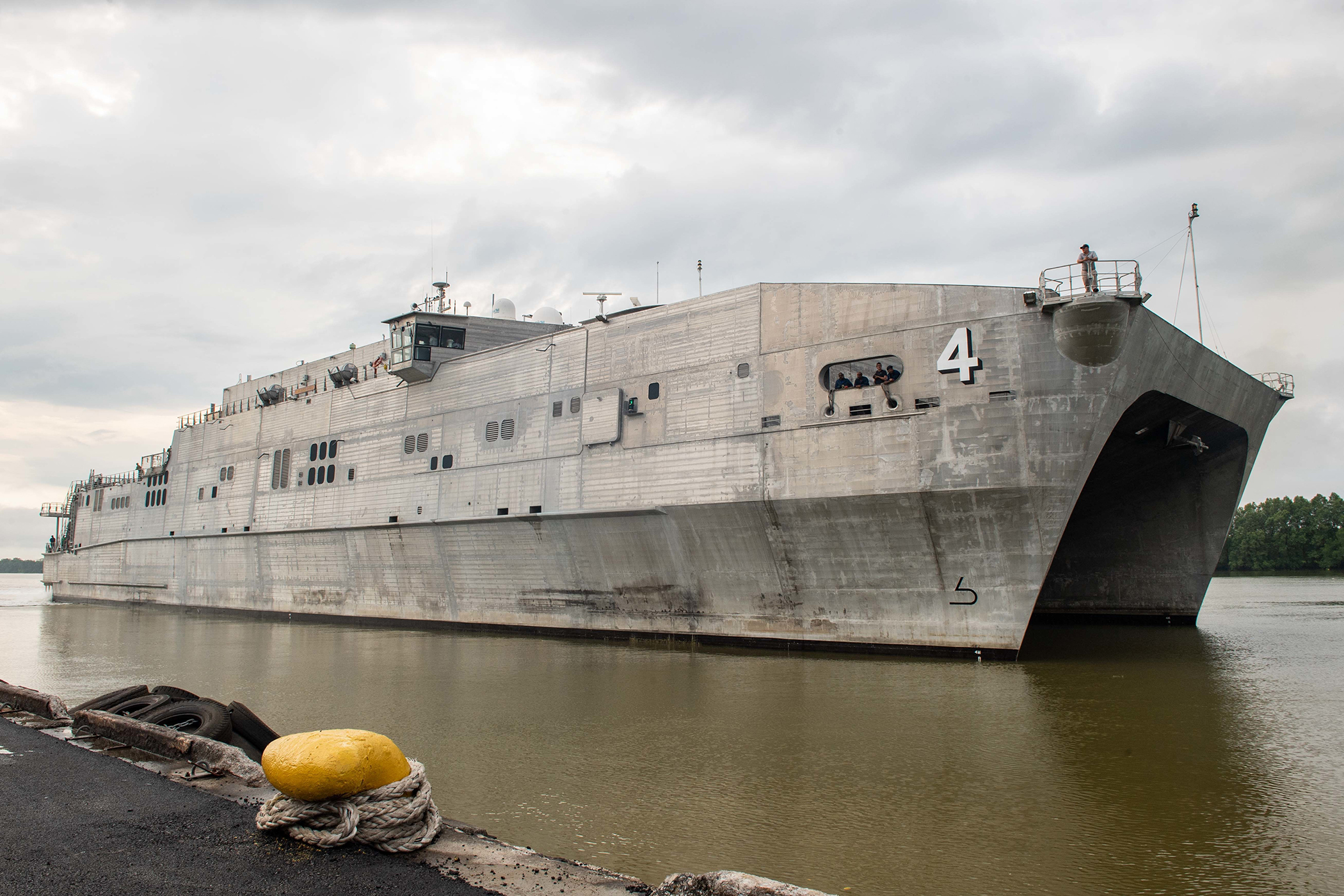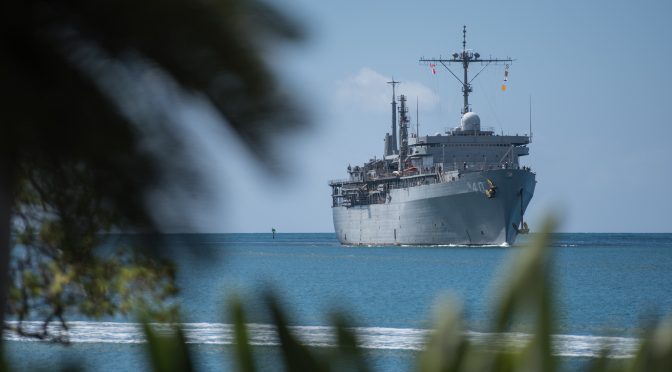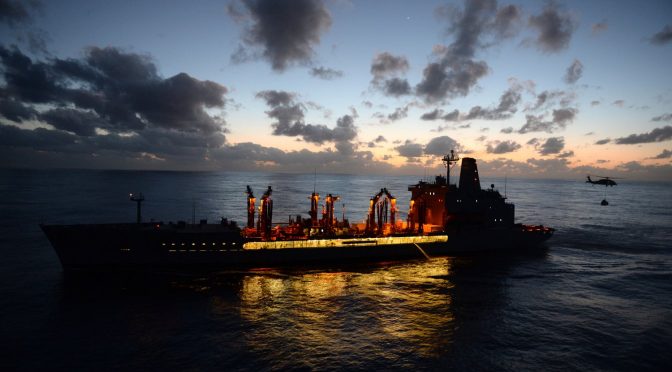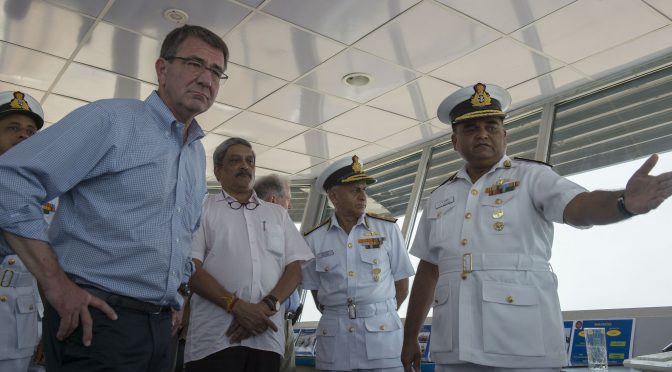By Walker Mills
In recent years the Pentagon has doubled down on a Pacific focus. It has published a new Pacific strategy and the individual services have been burning the midnight oil to write their own new concepts oriented around the Pacific.1 The Navy has released its classified new concept Distributed Maritime Operations,2 the Army has its Multi-Domain Operations concept,3 and the Marines are still working on Expeditionary Advanced Base Operations.4 All three concepts are predicated on an ability to maneuver through and within the First Island Chain. They assume the future operating environment will be heavily contested and involve threatened areas much farther from the central battlefields than the military has experienced in recent decades. In his recent planning guidance, the new Commandant of the Marine Corps warned:
“Potential adversaries intend to target our forward fixed and vulnerable bases, as well as deep water ports, long runways, large signature platforms, and ships…The ability to project and maneuver from strategic distances will likely be detected and contested from the point of embarkation during a major contingency.”5
Notably, this would negatively impact logistics and sustainment operations across the Pacific theater, and not just at the bleeding edge of the combat zone.
All the concepts seek to leverage distribution and rapid maneuver – whether through distribution of austere bases, task forces, or naval vessels. While they are intended to be broadly applicable the concepts are optimized for operations in the Western Pacific to counter a rising China and her military. Essential to all of these concepts is intra-theater mobility – moving lethality to the decisive point, but it has yet to be addressed in a meaningful way in acquisition and modernization priorities. The services have poured much needed resources into platforms and systems that can kill and destroy, but they have neglected to invest in operational mobility.
It does not appear that U.S. allies and partners in the region have the stomach for a larger basing footprint that would allow forces to be permanently or rotationally based forward. This begs the question – who is doing mobility and logistics? How will Army and Marine Corps advances in lethality actually reach a far-flung Pacific battlefield? How would the “forward deployment of multiple High-Mobility Artillery Rocket System (HIMARS) batteries armed with long-range anti-ship missiles” that Commandant Berger envisions actually happen in a contested environment?6
Shortfalls in Pacific Mobility
Today the intra-theater mobility requirement is largely filled by Expeditionary Fast-Transports (EFPs). These aluminum, double-hulled vessels are relatively new to the fleet but have been a continual disappointment. They have not been able to meet critical requirements for ship-to-ship transfers of supplies.7 They have sustained hundreds of thousands of dollars of damage in trans-oceanic voyages, voyages they would be needed for in a conflict.8 They have been plagued by maintenance issues. And perhaps worst, they have trouble operating in the open ocean because of the higher sea states there. An Operational Test and Evaluation Report concluded “The necessity of avoiding high sea states while transiting is an operational limitation that could be significant.” And “To utilize the speed capability of the ship, seas must not exceed Sea State 3 (significant wave height up to 1.25 meters).”9 A Department of Defense Inspector General report found 28 total deficiencies with the vessels in levels ranging from minor to severe, which means the deficiency in question “Precludes mission accomplishment.”10 The report found more than half of these deficiencies were either related to the vessels ability to meet cargo carrying requirement or network with the fleet – probably the two most important capabilities for the platform’s success.
Designed for inshore transport, the EFPs had been used successfully as short-haul commercial ferries between the Hawaiian Islands before the design was chosen by the Navy. But they are largely unsuitable for longer trips, like the nearly 1,600-kilometer trip between Okinawa and Tokyo, or the 1,700-kilometer trip between Okinawa and Manila, or the similarly lengthy trip to Guam. Today many of these trips are made by air or by Marines embarked on large, amphibious ships like the America class which may be too vulnerable and valuable to operate inside an enemy anti-access, area-denial envelope (A2/AD). The demand for these amphibious ships far outstrips the supply. Despite a longstanding (but recently waived) requirement of 38 amphibious ships set by Marine Corps leaders, the Navy’s current shipbuilding plan will not reach that number until 2033 or perhaps ever.11 Other sources, like the Heritage Foundation have argued that the requirement is as high as 45 amphibs.12 The Marine Corps went so far as to note this in their 2016 Marine Operating Concept that “We will likely continue to fall short of the number of amphibious warfare ships to meet CCMD operational demands…”13 Other transport programs like the Navy’s Common Hull Auxiliary Multi-Mission Platform (CHAMP), are still in the concept stages are likely fall in priority to other Navy programs because they are auxiliaries.14

A new platform for intra-theater mobility can share some of the burden carried by the larger amphibious ships.
Intra-theater mobility is critical to future Marine and Army operations. Littoral Operations in a Contested Environment specifically calls for the capability “…to employ scalable landing forces using a variety of platforms including amphibious ships as well as alternative capabilities…”15 But the short list of available platforms makes clear that this is not possible without acquiring new platforms or significantly modifying existing platforms. Seconding this sentiment, Commandant Berger noted in his planning guidance that:
“Our naval expeditionary forces must possess a variety of deployment options, including L-class and E-class ships, but also increasingly look to other available options such as unmanned platforms, stern landing vessels, other ocean-going connectors, and smaller more lethal and more risk-worthy platforms…We must also explore new options, such as inter-theater connectors and commercially available ships and craft that are smaller and less expensive, thereby increasing the affordability and allowing acquisition at a greater quantity.”
This specific capability gap is in addition to the yawning general capability gap the Navy is facing in logistics and sealift capability. A recent report by the Center for Strategic and Budgetary Analysis made clear their belief that the Navy and associated institutions were woefully deficient in sealift capability in the opening sentence of their report, “The current and programmed defense maritime logistics force of the United States is inadequate to support the current U.S. National Defense Strategy and major military operations against China or Russia.”16 Specifically the roll-on/roll-off (RO/RO) ships that Marines forces rely on to move tanks, light armored vehicles, HIMARS, and logistics vehicles in bulk are plummeting below acceptable readiness. “…even with service-life extension funding for 22 ships… 30 of 65 RO/RO vessels could age out within the next 15 years.”17 It is also worth noting that this scathing assessment did not even consider the potential requirements for emerging Marine Corps concepts requiring greater dispersion.
It would be negligent not to note the role of Marine and Air Force airlift – critical in moving around forces in theater, but it is not nearly enough. Not only are the available air transport options questionably survivable in the projected operating environment, but there are just not enough of them to do the whole job. Recall the infamous Millennium Challenge event where retired Marine General Paul Van Riper’s red force would have massacred the blue forces arriving on waves of rotary-wing aircraft.18 It is also likely that much of the extant airlift capacity would be tied up supporting expeditionary airfields per the Marines’ EABO concept or the Air Force’s “Rapid Raptor” concept leaving little to ferry ground forces.19
Other voices have also called for plugging the maneuver gap in the Pacific with new surface vessels. Douglas King and Brett Friedman recently called for a “Fighting Connector” in War on the Rocks that:
“…would use sea lines of communication to fill the gap between amphibious assault ships, sea-based assets, and Expeditionary Advance Bases (EABs) until shore-based threats are reduced. The size of the fighting connector would be in the range of sloop or small corvette class ships, displacing roughly 500 to 2,000 tons — a step or two smaller than the littoral combat ship.”20
A recent study by the Heritage Foundation noted “The Corps must work with the Navy to develop smaller, lower-cost ships that are better suited to the type of dispersed operational posture implied by LOCE.”21 And the Marine Corps itself has noted that it is deficient across the range of capabilities required to perform EABO. The authors of the 2016 Marine Corps Operating Concept summarized:
“The Marine Corps is currently not organized, trained, and equipped to meet the demands of a future operating environment characterized by complex terrain, technology proliferation, information warfare, the need to shield and exploit signatures, and an increasingly non-permissive maritime domain.”22
The Marines and the Army are investing in much needed, new ground vehicles and long-range, precision-fires capabilities essential for contributing to sea control or sea denial from the landward side of the battlefield. But the Navy and Air Force have also prioritized offensive systems like the FFG(X) and the F-35 programs. Even the Marines’ new CH-53K, ideally suited for moving vehicles, cannot cover the distances required by the theater with an external load.
Conclusion
This issue of lift is existential for Army and Marine operations in the Pacific. The theater is massive – in many cases hundreds or thousands of miles away from U.S. installations. The Marine Corps intends to distribute its forces widely, and has already begun. There is a new rotational force in Darwin, Australia, and a plan to move forces to Guam from Okinawa. This is good news, but these far-flung garrisons need platforms that can move them rapidly and in a survivable way to where they are needed in conflict. And these platforms need to be able to carry the gear essential to sea control like HIMARS rockets and G/ATOR radars, not just grunts.
If the United States wants to compete, deter, and win in a potential conflict its military needs to be able to move troops around the theater in question at will. To do this will require a reallocation of acquisition priorities and investments.
Walker D. Mills is an active duty Marine Corps infantry officer. He is currently studying Spanish at the Defense Language Institute. These views are presented in a personal capacity.
References
[1] Indo-Pacific Strategy Report: Preparedness, Partnerships and Promoting a Networked Region. Department of Defense (Washington, D.C.: 2019) https://media.defense.gov/2019/Jul/01/2002152311/-1/-1/1/DEPARTMENT-OF-DEFENSE-INDO-PACIFIC-STRATEGY-REPORT-2019.PDF.
[2] Megan Eckstein, “Navy Planning for Gray-Zone conflict; Finalizing Distributed Maritime Operations for High-End Fight,” USNI News (December 19, 2018) https://news.usni.org/2018/12/19/navy-planning-for-gray-zone-conflict-finalizing-distributed-maritime-operations-for-high-end-fight.
[3] “The U.S. Army in Multi-Domain Operations 2028,” TRADOC Pamphlet 525-3-1, U.S. Army (2018) https://www.tradoc.army.mil/Portals/14/Documents/MDO/TP525-3-1_30Nov2018.pdf.
[4] “EABO,” Marine Corps Warfighting Lab, webpage. Accessed July 15, 2019, https://www.candp.marines.mil/Concepts/Subordinate-Operating-Concepts/Expeditionary-Advanced-Base-Operations/.
[5] “Commandant’s Planning Guidance: 38th Commandant of the Marine Corps,” U.S. Marine Corps (2019) 1-4.
[6] “Commandant’s Planning Guidance,” 3.
[7] Brock Vergakis, “Report: Navy Ship Designed for Fast Transport Has Problems,” Military.com (28 April, 2018) https://www.military.com/daily-news/2018/04/28/navy-ship-designed-fast-transport-has-problems-report-says.html.
[8] Nick Stockton, “Yar! The Navy is Fixing Its Busted High-Speed Transport Ships,” Wired Magazine (January 20, 2016) https://www.wired.com/2016/01/yar-the-navy-is-fixing-its-busted-high-speed-transport-ships/.
[9] “Follow-on Operational Test and Evaluation (FOT &E) Report on the Joint High Speed Vessel (JHSV),” memo (September 22, 2015) https://news.usni.org/wp-content/uploads/2015/10/9-22-15-Follow-On-Operational-Test-and-Evaluation-FOTE-Report-on-the-….pdf#viewer.action=download.
[10] “Expeditionary Fast Transport Capabilities,” Inspector General of the Department of Defense (April 25, 2018) 6-7. https://www.oversight.gov/sites/default/files/oig-reports/DODIG-2018-107.pdf.
[11] Dakota Wood, “Rebuilding America’s Military: The United States Marine Corps,” The Heritage Foundation (March 21, 2019) 39. https://www.heritage.org/defense/report/rebuilding-americas-military-the-united-states-marine-corps.
[12] “U.S. Navy” The Heritage Foundation (October 4, 2018) https://www.heritage.org/military-strength/assessment-us-military-power/us-navy.
[13] “Marine Corps Operating Concept: How an Expeditionary Force Operates in the 21st Century,” U.S. Marine Corps (September 2016) 20. https://www.mcwl.marines.mil/Portals/34/Images/MarineCorpsOperatingConceptSept2016.pdf
[14] Megan Eckstein, “Navy Wants 2 Variants Next Common Auxiliary Hull: One for People, One for Volume,” USNI News (January 16, 2019). https://news.usni.org/2019/01/16/navy-wants-2-variants-next-common-auxiliary-hull-one-people-one-volume.
[15] “Littoral Operations in a Contested Environment,” U.S. Marine Corps (2017)17. https://news.usni.org/2017/09/26/document-marine-corps-littoral-operations-contested-environment-concept.
[16] Timothy A. Walton, Harrison Schramm and Ryan Boone, “Sustaining the Fight: Resilient Maritime Logistics for a New Era,” Center for Strategic and Budgetary Analyses (April 23, 2019) i. https://csbaonline.org/research/publications/sustaining-the-fight-resilient-maritime-logistics-for-a-new-era/publication.
[17] Ibid., 85.
[18] Micah Zenko, “Millenium Challenge: The Real Story of a Corrupted Military Exercise and Its Legacy,” War on the Rocks (November 5, 2015) https://warontherocks.com/2015/11/millennium-challenge-the-real-story-of-a-corrupted-military-exercise-and-its-legacy/.
[19] Blake Mize, “Rapid Raptor: getting the fighters to the fight,” U.S. Air Force Public Affairs (February 20, 2014) https://www.pacaf.af.mil/News/Article-Display/Article/591641/rapid-raptor-getting-fighters-to-the-fight/.
[20] Douglas King and Brett Friedman, “Why the Navy Needs a Fighting Connector: Distributed Maritime Operations and the Modern Littoral Environment,” War on the Rocks (November 10, 2017) https://warontherocks.com/2017/11/navy-needs-fighting-connector-distributed-maritime-operations-modern-littoral-environment/.
[21] Wood, “Rebuilding America’s Military,” 40.
[22] “Marine Corps Operating Concept,” 8.
Featured Image: EAST CHINA SEA (Feb. 4, 2019) – Marines assigned to the 31st Marine Expeditionary Unit (MEU) board an MV-22 Osprey assigned to the “Flying Tigers” of Marine Medium Tiltrotor Squadron (VMM) 262 aboard the amphibious assault ship USS Wasp (LHD 1) prior to flight operations. (U.S. Navy photo by Mass Communication Specialist 1st Class Daniel Barker)






